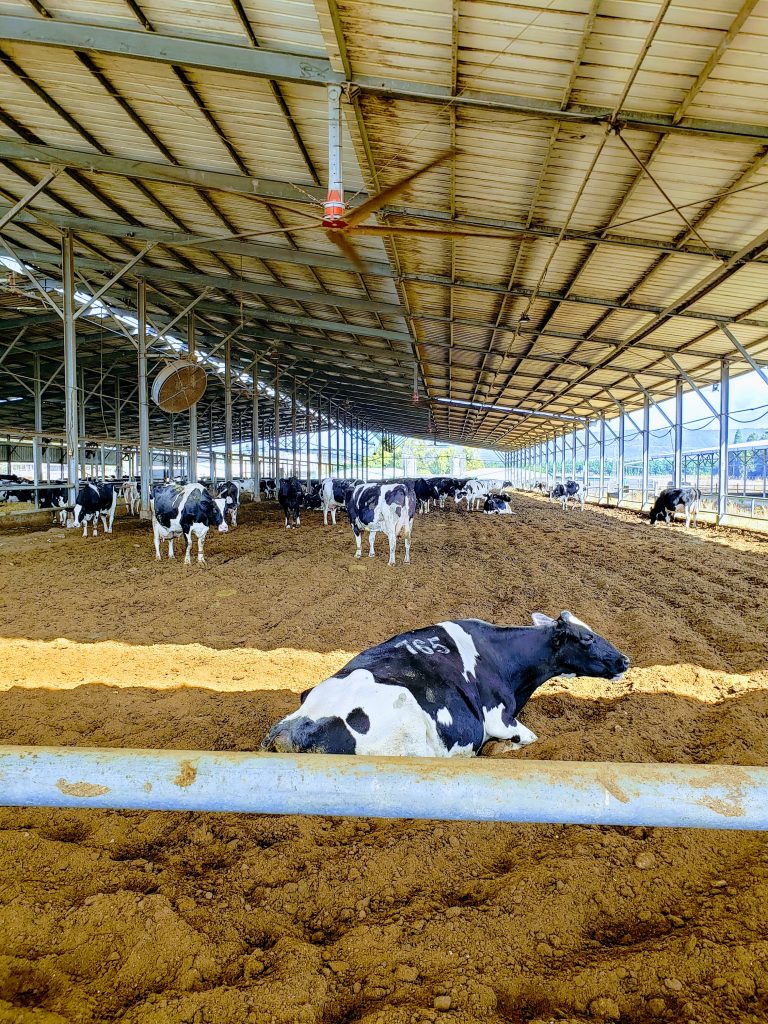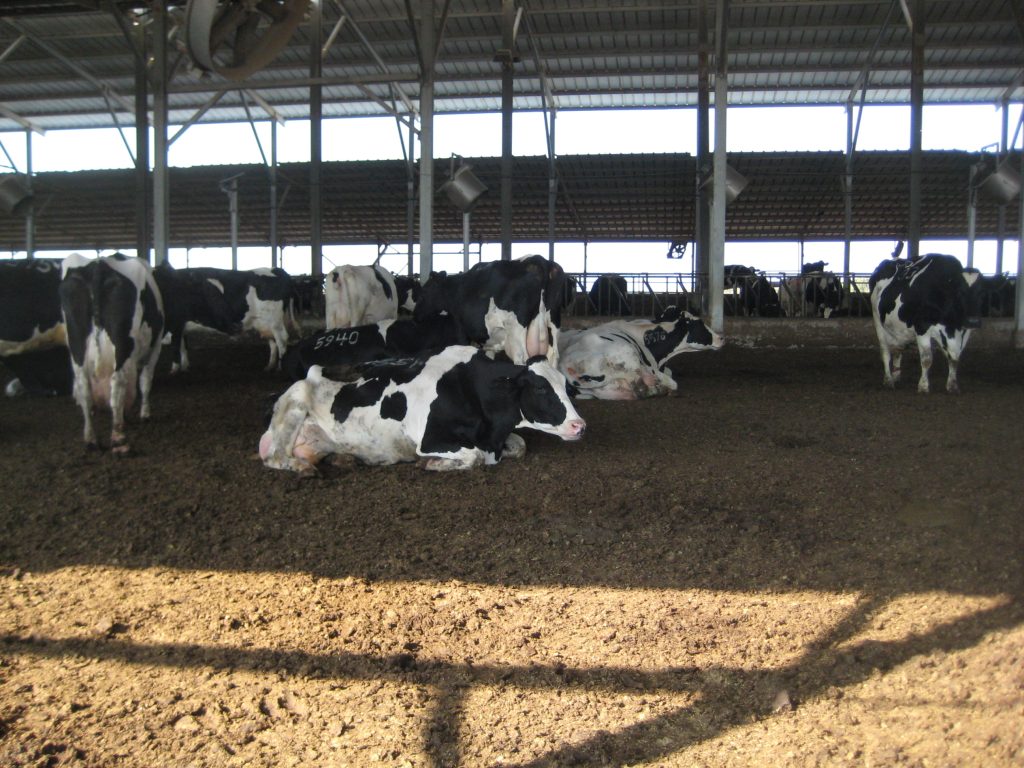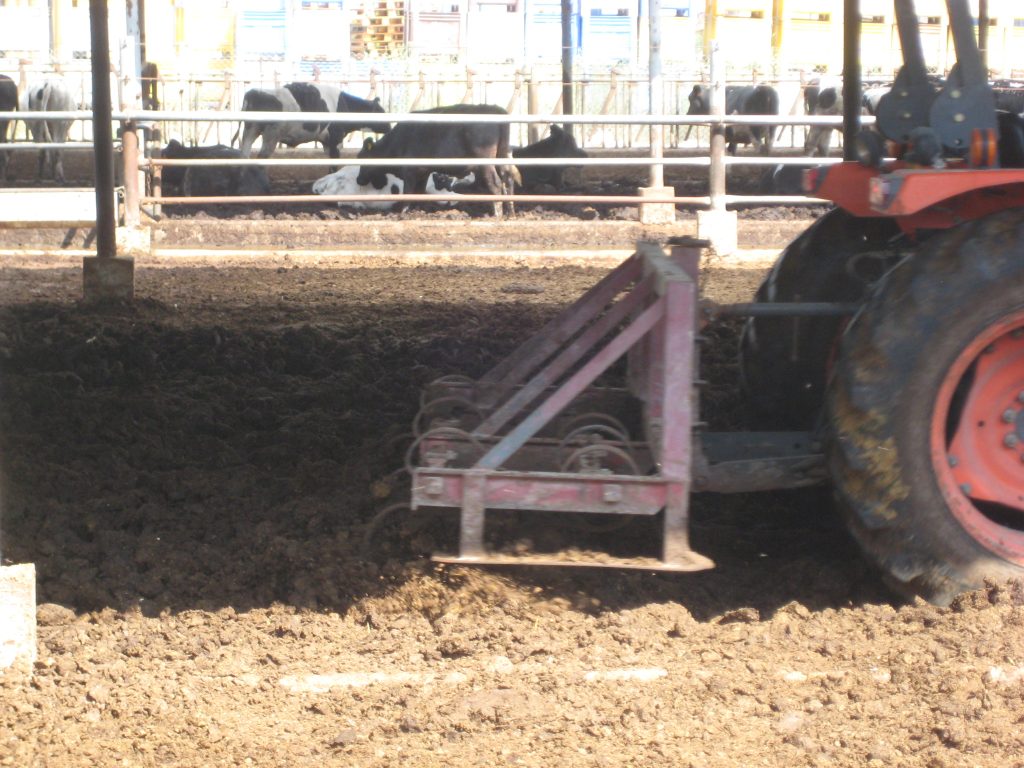Israeli model barn bedding system and Israeli model and applications in livestock
If you want cows that give birth every year without hoof diseases and mastitis this is possible with barns that provide natural living conditions .
ISRAEL TYPE SHELTERS
Israeli model type barn shelters have 22 square meters of living space including manger per animal. It is designed on the basis of using and drying the manure dung as a bedding litter. For this reason, the FAN or ventilation system are necessary for drying and ventilation is an indispensable part of the system for these kind of barns.
Shelters with 22 square meters of living space per animal and dried with a fan system under the shed

When designing animal shelters, it is necessary to know climatic conditions and what are the animal needs. Sometimes the barns, which are built with the thought of being very modern, cause irreversible damage, contrary to what is believed. It causes irreparable problems for the economy and your cows.
Effects of barn model on animal health
While problems such as foot hoof diseases and mastitis are not generally seen in pasture-based businesses, they can be seen very frequently and intensely in shelters that are closed and do not have a walking area.
Like Israel, the above problems are almost non-existent in shelters that do not have pasture, but are designed by imitating nature, with 22 m2 living space per animal under a shed, and which dried with a fan or ventilation system . However, the investment to be made without meeting the requirements of this model may result in complete disappointment.

The Israeli model in animal husbandry and the striking features of Israeli-type sheltered businesses.
Generally, there are no veterinarians in enterprises, and there is no drug store.
It drew my attention that there was no special protection or disinfectant room during our visit in these disease-free establishments. Most importantly, I observed that there were no odors and flies in the barns, and the birds were very few and generally outside the barn.
Apart from this, no workers work on the farm, and only at the time of milking the workers come, milk them and give their feed.
Animals in estrus are reported to the contracted veterinarian. Other sick animals and animals with reduced productivity are sent directly to slaughter as soon as the treatment method is applied. For this reason, the animal circulation rate is very high and the average lactation.
But the manure bedding correction officer enters the barn as soon as the animals are going to be milked (at least 2 – 3 times a day depending on the number of milking), ventilating and leveling the dried manure by turning it 25-30 cm upside down

2019 Israeli Dairy Board Kibbutz (cooperative) Production Figures
- Average milk production per cow: 12, 025 Kg/year (2260 pounds/year)
- Average fat content: 3.59%, 435 Kg
- Average protein content: 3.17%, 384 Kg
- The highest average yearly milk yield per cow in an Israeli cooperative dairy farm (Ein HaShlosha) Kg 14463 (31,885 pounds)
Why the Israeli model? Dry and hot weather…..
First of all, it should be known that animal excrement is not fertilizer . A long and laborious process is required for animal feces to become fertilizer. Sometimes the FERTILIZER of our small farmers! We watch his pleas on TV and on the news that he was punished for spilling it on the field.
A dairy cow excretes approximately 50 kg of solid feces per day, of which an additional 15 kg is liquid. If we consider a herd of 500 heads, only dairy cows excrete 25,000 kg per day. A cow excretes 0.05 cubic meters per day, which is 500 X 0.05 = 25 cubic meters.
A dairy cow produces 8% of its average live weight (a 600 kg cow 50 kg of feces and urine) waste per day. In general, a cow weighing 600 kg produces approximately 50 kg of solid manure + liquid manure per day. For example, a Holstein cattle that gives 23 kg of milk and produces 59 kg of feces per day (2.6 kg of feces per kg of milk) produced 80 kg of feces when its milk yield increased to 45 kg (Weiss and St-Pierre, 2010). This corresponds to the production of 1.75 kg of feces for 1 kg of milk. A fattening calf with a live weight of 453 kg produces 28 kg of fresh solid manure + urine. A cow with a live weight of 453 kg produces 12 tons of manure per year, and a calf produces 5 tons of manure per year.
Why is the Israeli model farm and barn system indispensable for Israel?
the Dairy Industry in Israel 2012
ISRAEL CATTLE BREEDERS ASSOCIATION Linkhttp://www.icba-israel.com/cbase/2012.pdf
1-Legal obligations
- Due to the scarcity of water resources and the very important groundwater in Israel, wastewater is not allowed to mix with the soil.
- There are legal obligations and heavy sanctions regarding the disposal of feces and their conversion into fertilizers.
- Due to the scarcity of land, zoning permit restrictions, and limitations on construction and concrete use, ISRAEL has developed a unique method.
2-Manure management system
- In order to convert the feces into fertilizer in the fastest, easiest and cheapest way, dry feces are used as a litter on the ground, when mixed and ventilated (1-3 times a day); This method is the first choice because it can turn into fertilizer in 5-6 months.
- The barn floors are made of sealed concrete to prevent excrement from mixing with the soil and reaching groundwater. The stool is laid on this concrete and within 6 months, the thickness of the stool can reach up to 1.5 meters. The barn floors are made deep for this reason.
- The stool, which is used as a litter every 6 months on average, is removed after it turns into fertilizer , and it is renewed by allowing stool to accumulate again.
3-Climate Conditions
- In order to use manure as a bedding material, it must be dry and moisture-free. Diseases in animals that do not dry out, make barn management impossible.
- In environments where there is no rain throughout the year and the air humidity is low, the dung dries immediately. Additional drying is required, so a fan is used .
- The biggest cause of hoof diseases are wet floors. (In shelters that are not blown or ventilated, the ground does not dry out and remains wet). In these cases, high quality fan air circulation should be provided.
- The second preference is that the climatic environment required for the feces to be turned into fertilizer is in Israel.
4-Management and investment
- Since there are not many buildings such as infirmary, walkways, administrative buildings in Israeli type shelters, they allocate large areas for barns. When planning shelters, it provides sufficient space for future targets and capacity, and convenience for additional shelters in case of growth.
- It is designed on the basis of no bedding, 22 square meters of living space including manger per animal, and drying of dry feces in the shelter. It provides animal welfare and ease of management.
- The expectation for milk yield is very high. The important thing is to get the most milk in the shortest time while the animal is healthy.
- Animal life (Herd rate of change) Sick animal means cost and yield loss. Time, personnel and money resources cannot be spent on treatment and treatment expenses .
An investment without the Israeli model barn requirements can result in complete frustration.

If the climate of the region where the barn will be built is not dry (low humidity): It is almost impossible to dry the faeces. This causes undesirable results.
- Ground; Daily mixing becomes impossible, mud consistency is formed.
- The ground turns into a sea of feces or a swamp of feces.
- It freezes in cold weather, causing broken feet or excessive heat and energy loss of animals.
- Foot diseases and skin diseases increase rapidly.
- Skin lesions and hair loss begin.
If the climate of the region where the barn will be built is not hot:
- In addition to the formation of flies and bacteria, the smell of feces and ammonia occurs.
- Fermentation cannot occur in feces and fertilizer formation does not occur.
- Costly and laborious processes are required to separate the liquid portion from the feces.
- Since there is no liquid evaporation, animals remain in contaminated water/feces.
- Liquid that does not evaporate increases the risk of mixing with the soil.
Compost Shelters (compost bedding)
Compost shelters are similar to Israeli-type shelters, but the most important difference from Israel is that compost is made instead of drying feces. In Israeli-type barns, 22 square meters per animal is sufficient, while 8 square meters is sufficient for compost. In composts, 20 cm thick sawdust should be thrown on the manure every 10 days. The floor is ventilated by making it upside down twice a day.
Compost shelters are suitable for all types of shelters. Roofed shelters without pillars are most ideal because the tractor must have freedom of movement inside to ventilate the excrement. In addition, it provides a great benefit in that the side walls are opened and the curtains are closed.
We can call it the other “Compost Shelter”. Below is the address of an article published in Canada on the subject http://www.omafra.gov.on.ca/english/engineer/facts/15-025.htm
Possible harms of using compost as litter bedding
Extreme temperatures in the compost can cause spontaneous combustion, but this is very rare even among superheated compost piles. Properly ventilated and moist compost piles are not dangerous no matter how hot they are. Hot compost, which is quite closed, will not catch fire if kept moist.
What Causes Overheated Compost Piles to Flare?
A rare combination of events can cause a compost pile to catch fire. All of these must be met before the opportunity arises. The first is dry, unattended material with non-uniform, mangled pockets of debris. Next, the pile must be large and insulated with limited airflow. And finally, improper moisture distribution throughout the pile. Only the largest piles are truly endangered if mismanaged, as with commercial composting operations. The key to preventing any problems is proper care of your organic matter to avoid hot compost bins or piles.
Read more at Gardening Know How: My Compost Is Too Hot: What To Do About Overheated Compost Piles https://www.gardeningknowhow.com/composting/basics/overheated-compost-piles.htm
Israeli Model barns versus European
1-Israeli Model
Most farms in Israel (> 90%) workwithout cubicles and save money for dividers, for walking alleys, crossings and so on!
- They only have
- open,unstructured lying areas
- feeding alleys
- feeding tables
- Open, un structured lying areas offer a space of 18 – 20 m² per cow and cows can lay down where they want.
- Ground is made out of
- dried manure (below is concrete!)
- maybe some sand
- absorbent material that we know as “CATSAN” (white stuff that can take and absorb urine)
- Ground/soil is
- minimum1 time, often 2 times per day equalized with tractor. and harrow (heavy unitwith “iron teeth”) so that ground gets
flat and without deepholes in soil. - Dried with strong ventilation systems in spite of the fact that temperature is always between 25 – 45°C and hardly any rain.
- minimum1 time, often 2 times per day equalized with tractor. and harrow (heavy unitwith “iron teeth”) so that ground gets
- exchanged maybe once or twice a year.
- When there is rain fall aarea becomes (at least there where rain comes in) immediately mud, but 1 day later everything is dry again because
of natural weather conditions, ventilation and farmers treatment.
2-European Copy
- Israeli investors who run farms in Europe (mainly RO and BG) want to use the “Israeli model” also in Europe.
- European farms (mainly BG) visiting Israel want to “copy” the system, but I have not yet seen any “copy” that works.
- Problem is that in Europa
- weather conditions are different; much more rain, much more wetness, cold temperatures, even ice.
farms are much too lazy for daily equalizing the floor. - farms do not have strong ventilation systems.
- weather conditions are different; much more rain, much more wetness, cold temperatures, even ice.
Result: mud and dirt – dirt and mud! Holes in the ground where cows fall in with their legs and legs might get broken!
- “Israeli Model” done by European farmers are – to all my present experience – just an “excuse” for being lazy andnot taking care of the cows.
- In Israeli farms in Europa the local farm managers would like to shift to lying box systems but Israeli investors reject all these ideas and insist on their model. They do not want to make investments in lying boxes.
“What works in Israel has to work every where!”


